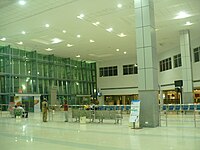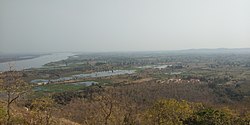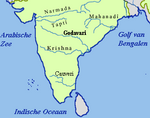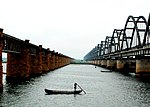Nagpur district
Nagpur district | |
|---|---|
Clockwise from top-left: Deekshabhoomi, Nagardhan Fort, Kalidas Memorial at Ramtek, Rivers at Ambhora, Stone circles of Junapani | |
 Location in Maharashtra | |
| Coordinates (Nagpur): 21°00′N 79°00′E / 21.000°N 79.000°E | |
| Country | |
| State | Maharashtra |
| Division | Nagpur |
| Headquarters | Nagpur |
| Tehsils | 1. Ramtek, 2. Umred, 3. Kalameshwar, 4. Katol, 5. Kamthi, 6. Kuhi, 7. Narkhed, 8. Nagpur, 9. Nagpur (Rural), 10. Parseoni, 11. Bhiwapur, 12. Mouda, 13. Savner, 14. Hingna |
| Government | |
| • Guardian Minister | |
| • Divisional Commissioner |
|
| • District Collector |
|
| • District Council CEO |
|
| • MPs | |
| Area | |
• Total | 9,892 km2 (3,819 sq mi) |
| Population (2011) | |
• Total | 4,653,570 |
| • Density | 470/km2 (1,200/sq mi) |
| • Urban | 64.26% |
| Demographics | |
| • Literacy | 89.5% |
| • Sex ratio | 948 |
| Time zone | UTC+05:30 (IST) |
| Average annual precipitation | 1205 mm |
| Nominal gross domestic product(Nagpur district) | INR 1,81,665 (2022-2023) [2] |
| Per capita income(Nagpur district) | INR 1,74,442 (2019-20) [3] |
| Website | nagpur |
Nagpur district (Marathi pronunciation: [naːɡpuːɾ]) is a district in the Vidarbha region of Maharashtra state in central India. The city of Nagpur is the district administrative centre. The district is part of Nagpur Division.
Nagpur district is bounded by Bhandara district on the east, Chandrapur district on the southeast, Wardha district on the southwest, Amravati district on the northwest and Chhindwara district and Seoni district of Madhya Pradesh state on the north.
History
[edit]In 1853, after the death of Raghoji III, the princely state of Nagpur was annexed by the British and the territory occupied by the present district became part of the then Nagpur Province. In 1861, it was merged with the Central Provinces. In 1903 it became part of the Central Provinces and Berar. In 1950 Nagpur district was created as became part of the newly formed Madhya Pradesh state and Nagpur became its capital. In 1956, after a reorganisation of Indian states, Nagpur district was incorporated into Bombay state. On 1 May 1960, it became a district of Maharashtra state.
Geography
[edit]
Climate
[edit]| Nagpur | ||||||||||||||||||||||||||||||||||||||||||||||||||||||||||||
|---|---|---|---|---|---|---|---|---|---|---|---|---|---|---|---|---|---|---|---|---|---|---|---|---|---|---|---|---|---|---|---|---|---|---|---|---|---|---|---|---|---|---|---|---|---|---|---|---|---|---|---|---|---|---|---|---|---|---|---|---|
| Climate chart (explanation) | ||||||||||||||||||||||||||||||||||||||||||||||||||||||||||||
| ||||||||||||||||||||||||||||||||||||||||||||||||||||||||||||
| ||||||||||||||||||||||||||||||||||||||||||||||||||||||||||||
| Climate data for Nagpur | |||||||||||||
|---|---|---|---|---|---|---|---|---|---|---|---|---|---|
| Month | Jan | Feb | Mar | Apr | May | Jun | Jul | Aug | Sep | Oct | Nov | Dec | Year |
| Record high °C (°F) | 33 (91) |
37 (99) |
41 (106) |
47 (117) |
49 (120) |
45 (113) |
38 (100) |
40 (104) |
39 (102) |
37 (99) |
35 (95) |
32 (90) |
49 (120) |
| Mean daily maximum °C (°F) | 28.6 (83.5) |
32.1 (89.8) |
36.3 (97.3) |
40.2 (104.4) |
42.6 (108.7) |
37.8 (100.0) |
31.5 (88.7) |
30.4 (86.7) |
31.8 (89.2) |
32.6 (90.7) |
30.4 (86.7) |
28.2 (82.8) |
33.5 (92.3) |
| Mean daily minimum °C (°F) | 12.4 (54.3) |
15.0 (59.0) |
19.0 (66.2) |
23.9 (75.0) |
27.9 (82.2) |
26.3 (79.3) |
24.1 (75.4) |
23.6 (74.5) |
22.9 (73.2) |
19.8 (67.6) |
14.9 (58.8) |
12.1 (53.8) |
20.2 (68.4) |
| Record low °C (°F) | 7 (45) |
8 (46) |
12 (54) |
17 (63) |
18 (64) |
20 (68) |
20 (68) |
20 (68) |
19 (66) |
11 (52) |
5 (41) |
3.5 (38.3) |
3.5 (38.3) |
| Average precipitation mm (inches) | 10.2 (0.40) |
12.3 (0.48) |
17.8 (0.70) |
13.2 (0.52) |
16.3 (0.64) |
172.2 (6.78) |
304.3 (11.98) |
291.6 (11.48) |
194.4 (7.65) |
51.4 (2.02) |
11.8 (0.46) |
17.2 (0.68) |
1,112.7 (43.81) |
| Source: [4] | |||||||||||||
Divisions
[edit]Nagpur district is divided into 14 talukas: Ramtek, Umred, Kalameshwar, Katol, Kamptee, Kuhi, Narkhed, Nagpur, Nagpur Rural, Parseoni, Bhiwapur, Mouda, Savner and Hingna.
| Sub-Division | Tahsils |
|---|---|
| Nagpur City |
|
| Nagpur Gramin |
|
| Kamptee |
|
| Umred |
|
| Ramtek |
|
| Saoner |
|
| Katol |
|
Nagpur district has 12 Vidhan Sabha constituencies: Nagpur South West, Nagpur South, Nagpur East, Nagpur Central, Nagpur West, Nagpur North, Katol, Savner, Hingna, Umred, Kamthi and Ramtek. The first six constituencies are part of Nagpur Lok Sabha constituency and rest are part of Ramtek Lok Sabha constituency.[5]
Administration
[edit]Members of Parliament
[edit]Guardian Minister
[edit]District Magistrate/Collector
[edit]- Dr.Vipin Itankar (IAS) (2018 - Incumbent)
Demographics
[edit]| Year | Pop. | ±% p.a. |
|---|---|---|
| 1901 | 748,489 | — |
| 1911 | 806,287 | +0.75% |
| 1921 | 789,940 | −0.20% |
| 1931 | 936,987 | +1.72% |
| 1941 | 1,056,537 | +1.21% |
| 1951 | 1,230,535 | +1.54% |
| 1961 | 1,508,455 | +2.06% |
| 1971 | 1,942,688 | +2.56% |
| 1981 | 2,588,811 | +2.91% |
| 1991 | 3,287,139 | +2.42% |
| 2001 | 4,067,637 | +2.15% |
| 2011 | 4,653,570 | +1.35% |
| source:[6] | ||
According to the 2011 census Nagpur district had a population of 4,653,570,[8] roughly equal to the nation of Ireland[9] or the US state of South Carolina.[10] This gives it a ranking of 29th in India (out of a total of 640).[8] The district has a population density of 470 inhabitants per square kilometre (1,200/sq mi) .[8] Its population growth rate over the decade 2001–2011 was 14.39%.[8] Nagpur has a sex ratio of 948 females for every 1000 males,[8] and a literacy rate of 89.52%. 68.31% of the population live in urban areas. Scheduled Castes and Scheduled Tribes make up 18.65% and 9.40% of the population respectively.[8]
| Year | Male | Female | Total Population | Change | Religion (%) | |||||||
|---|---|---|---|---|---|---|---|---|---|---|---|---|
| Hindu | Muslim | Christian | Sikhs | Buddhist | Jain | Other religions and persuasions | Religion not stated | |||||
| 2001[11] | 2105314 | 1962323 | 4067637 | - | 75.980 | 7.294 | 0.779 | 0.483 | 14.486 | 0.556 | 0.360 | 0.063 |
| 2011[12] | 2384975 | 2268595 | 4653570 | 14.405 | 75.044 | 8.402 | 0.745 | 0.440 | 14.356 | 0.527 | 0.262 | 0.226 |
At the time of the 2011 Census of India, 70.11% of the population spoke Marathi, 17.71% Hindi, 4.20% Urdu, 1.39% Chhattisgarhi, 1.09% Gondi and 0.97% Sindhi as their first language.[13]
Urban areas
[edit]The current District Collector is Abhishek Krishna. Nagpur district is made up of the following administrative bodies:[14]
- Nagpur Municipal Corporation
- Nagpur Improvement Trust
- Narkhed Municipal Council
- Katol Municipal Council
- Saoner Municipal Council
- Ramtek Municipal Council
- Mowad Municipal Council
- Khapa Municipal Council
- Umred Municipal Council
- Narkhed Municipal Council
- Kalmeshwar Municipal Council
- Kamptee municipal Council
Transport
[edit]

Due to its central location in India, the Nagpur Railway Station is an important railway junction. It is a transit terminal for trains that connect the country lengthwise and breadthwise, especially trains connecting India's major metropolises, Mumbai to Howrah-Kolkata, Delhi and Jammu to Chennai, Hyderabad, Bangalore and Kanyakumari in the South, as well as western cities such as Pune and Ahmedabad.[15]

Nagpur is also a major road junction as India's two major national highways, Kanyakumari-Varanasi (NH 7) and Hajira-Kolkata (NH 6), pass through the city.[15] Highway number 69 connects Nagpur to Obaidullaganj near Bhopal. Nagpur is at the junction of Asian HigLanka and AH46 connecting Kharagpur to Dhule.
The MSRTC buses run a cheap transport service in and around the district, reaching out to even the most remote areas of the district.
Dr. Babasaheb Ambedkar International Airport in Sonegaon, Nagpur, is a domestic and international airport, which connects Nagpur to Mumbai, Delhi, Sharjah, Dubai and Muscat via Doha .
References
[edit]- ^ "District Nagpur".
- ^ "Economic Survey of Maharashtra 2023-24 (Marathi) : Annexure 3.9" (PDF). Retrieved 8 July 2024.
- ^ Records, Official. "Per capita income Districts of Maharashtra 2019-20". economy Department, Government of Maharashtra, India. Maharashtra Vidhanmanda.
- ^ "Nagpur, India". Whetherbase. Retrieved 1 July 2010.
- ^ "District wise List of Assembly and Parliamentary Constituencies". Chief Electoral Officer, Maharashtra website. Archived from the original on 18 March 2010. Retrieved 1 November 2010.
- ^ Decadal Variation In Population Since 1901
- ^ "Population by Religion - Maharashtra". censusindia.gov.in. Registrar General and Census Commissioner of India. 2011.
- ^ a b c d e f "District Census Hand Book – Nagpur" (PDF). Census of India. Registrar General and Census Commissioner of India.
- ^ US Directorate of Intelligence. "Country Comparison:Population". Archived from the original on 13 June 2007. Retrieved 1 October 2011.
Ireland 4,670,976 July 2011 est.
- ^ "2010 Resident Population Data". U. S. Census Bureau. Retrieved 30 September 2011.
South Carolina 4,625,364
- ^ Census India 2001.
- ^ Census India 2011.
- ^ a b "Table C-16 Population By Mother Tongue: Maharashtra". census.gov.in. Registrar General and Census Commissioner of India. 2011.
- ^ "Planning Authority of Nagpur district". Government of Maharashtra. Archived from the original on 10 April 2009. Retrieved 8 January 2009.
- ^ a b Deshpande, Vivek (4 May 2006). "Nagpur stakes claim to lead boomtown pack". The Indian Express. India. Archived from the original on 29 September 2007. Retrieved 22 June 2006.











